- Mosquitoes
- Insects of Crimea
- Salpuga and angiope
- Karakurt and tarantula
- Tick and Scolopendra
- Insects of Crimea
The Crimean peninsula is known for its health resorts, beaches, an abundance of architectural monuments, a wide range of landscapes, unique original nature. The insects of Crimea deserve special attention. According to entomologists, more than 15 thousand species inhabit this territory. Some insects are mundane, others can be admired and touched, and some representatives should be feared.
The species composition of insects in Crimea
95% of the total entomofauna in the Crimea is accounted for by representatives of 5 groups:
- dipterans: flies, horseflies, mosquitoes, midges;
- Lepidoptera: mole, moths, butterflies (about 2500 species);
- hymenoptera: ants, riders, sawflies, wasps, bees;
- hard-winged: more than 4000 species of beetles;
- half-winged: insects with an incomplete transformation cycle - 2000 types of bugs.
The remaining 5% are represented by smaller orders of insects, the variety of species in which ranges from several units to hundreds. Among them are dragonflies, praying mantises.
Interesting!
Pine Hog, Chaferlive in border regions with Crimea. However, despite the high migration abilities, the presence of food supply, they are not in a hurry on the peninsula. Scientists have to figure out this riddle.
Dangerous Crimean insects
There are no mortally poisonous insects for humans in the Crimea. There are no tsetse flies on the peninsula, killer ants, asian hornets, or fluffy caterpillars of Megalopyge opercularis. The poisonous insects of the Crimea are represented by more harmless creatures, and even then they pose a threat to people prone to allergic reactions.
Mosquitoes
Locals often call them mosquitoes. These squeaky creatures do not differ in appearance and lifestyle from their foreign counterparts. Most of all, females, who need blood for reproduction, annoy the man. Males are harmless in the wave - they are content with flower nectar. About 40 species of blood-sucking mosquitoes live in Crimea. According to vacationers, the least of them are on the South Coast, in Yevpatoriya. The peak of activity is from June to July.
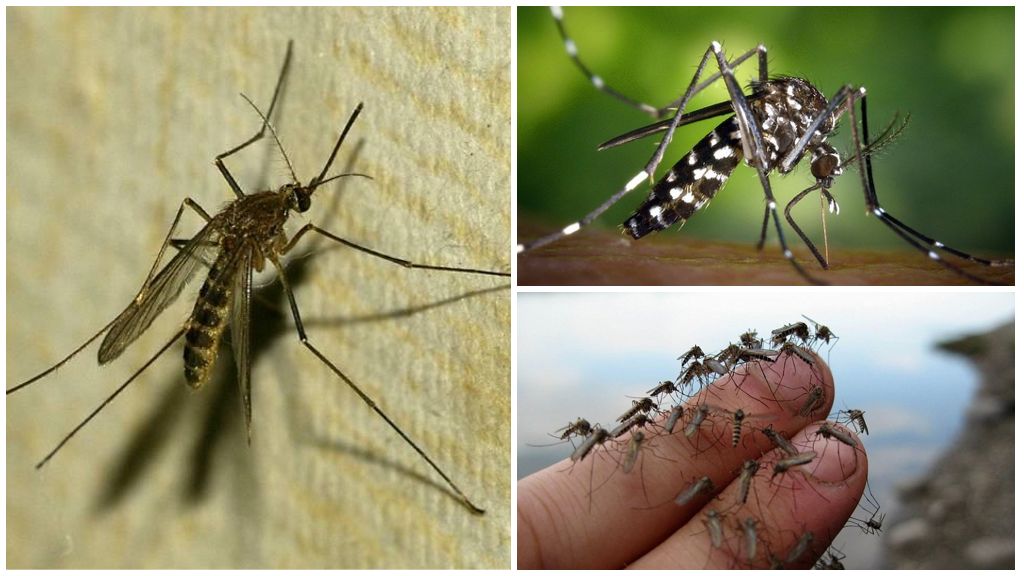
On a note!
Lack of mosquitoes on the south coast from Sevastopol to Sudak, the invasions of real mosquitoes compensate. Also they are in the region of Simferopol, Bakhchisarai.
Dwell on the peninsula and more dangerous malaria mosquitoes. Accumulations of populations are recorded in the northern part of Crimea. The consequences of mosquito bites: itching, redness, in rare cases, severe swelling develops. Treatment is carried out by disinfecting bitten places, treatment with ointments and taking antihistamines. To avoid mosquito bites will help repellents and fumigators.
Bells
Biting individuals that look like mosquitoes, but very small. Dwell biting midges in Eastern Crimea, on the resorts of the west coast. The bites are very painful, for a long time they remind themselves of a constant itching. Treatment and protection are carried out by the same means as from mosquitoes.
Important!
Dangerous insects of the Crimea - biting midges carry the hemorrhagic fever of the Crimea-Congo, tularemia.
Hornets, wasps and bees
A number of species are listed in the Red Book.Given that few people can instantly determine the species of an insect, it is better to scare it away, but not to kill it. The bites of stinging individuals are most dangerous if they are produced in the neck, face. Severe consequences are observed in allergic people: shortness of breath, nausea, severe swelling. It is recommended to treat the wounds with saline or alcohol solution and use an antihistamine.
Gadgets
The peak of activity is from May to September. Oversized flies drink the blood of mammals, humans. Bloodsucking are females. Accumulations of insects are always near water bodies.
The bites are painful. But the danger lies elsewhere. People with allergies to insect saliva can develop anaphylactic shock. Also horseflies are carriers of a number of dangerous diseases: filariasis, tularemia, anthrax. To protect yourself from biting flies, you must use repellents.
On a note!
Some species, for example, Smirnov’s horsefly, are in the Crimea on the verge of extinction.
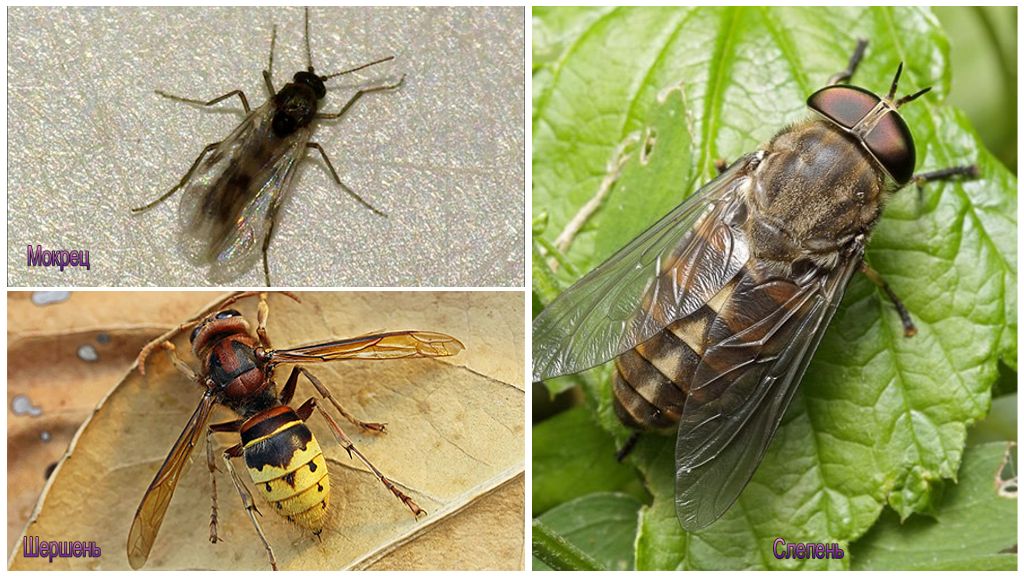
Not insects, but very dangerous
Often arachnids and millipedes are considered to be dangerous insects of the Crimea. And although they are not six-legged, they belong to other units and superclasses, they cannot be ignored. Moreover, the toxicity of these creatures is much higher than that of insects of the peninsula. People who prefer “seals” to rest on the beaches have nothing to fear - the chances of meeting a dangerous creature are practically zero. But for tourists planning to go on hikes, trekking into the mountains, steppes, it is recommended to familiarize themselves with the photos and descriptions of poisonous arthropods.
Karakurt
The most dangerous spider in Crimea, belongs to the genus black widows. The most poisonous females, especially a high concentration of poison are observed during the breeding season. Meeting with karakurt ends with contemplation of the walls of the hospital ward. If untreated, death is possible.
Interesting!
Black widows are called spiders by chance. After mating, the female simply eats the boyfriend.
Favorite habitats of a spider in Crimea are steppes, stone blockages. But often found in squares and parks. Most black widows are on the west coast near Cape Tarhankut.
On a note!
Localization of karakurt can be determined by the abundance of horizontal cobwebs on the ground.
Appearance memorable:
- the size of males is up to 7 mm, females are larger - up to 2 cm;
- spherical abdomen of black color with 13 red blotches;
- 8 long paws.
Karakurts do not choose people as objects for hunting, do not differ in aggressive disposition. But, if they feel threatened - they can bite. Most often this happens when the spider is accidentally crushed during outdoor recreation.
After a bite of a karakurt, a burning pain immediately appears, quickly spreading to the abdomen, lower back, chest. There may also be tremor, shortness of breath, dizziness, nausea.
Important!
The victim must be taken to a health care center where he will be given an antidote. Within 2 minutes after spider bite you can use the method of P.I. Marikovsky - burn a bitten place with a burning head of a match. However, in the absence of skills, the victim runs the risk of getting a burn. In any scenario, the black widow's victim needs qualified medical attention.
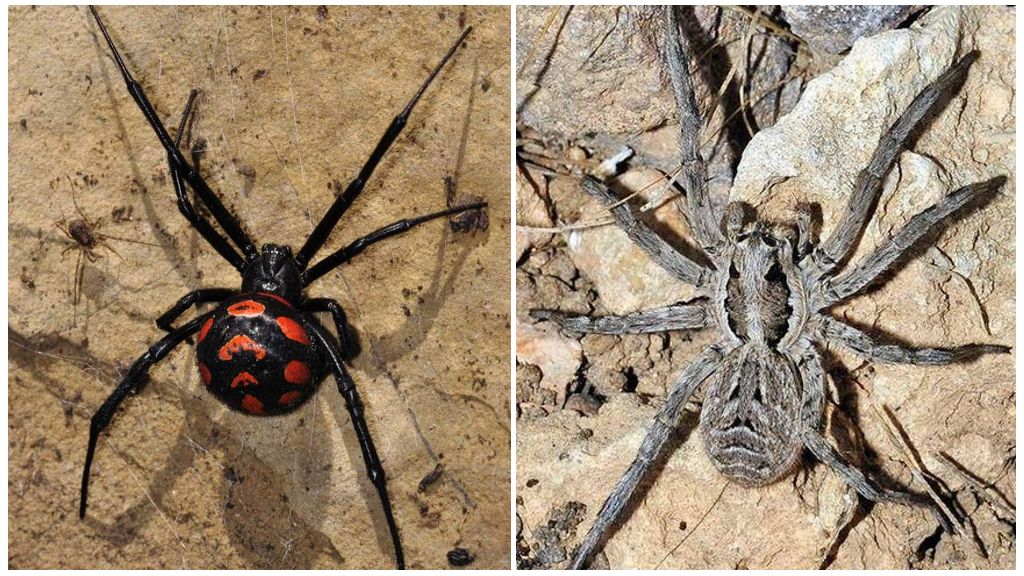
Tarantula
The South Russian tarantula is widespread in Crimea. Spider from wolf families, in use - misgir. It lives in forest-steppe, steppe zones. Frequent guest in the gardens. What it looks like:
- dimensions do not exceed 3 cm;
- reddish-gray color above, black below;
- a characteristic feature is a speck on the head that resembles a hat;
- the body is densely covered with bristles, creating a hairy-looking spider.
Can bite by accident. Pain after a bite of a misgir is comparable to a bite of a wasp or a bee. In the affected area, swelling is possible.
On a note!
In some victims, the skin around the bite of the tarantula becomes yellow. The natural color of the skin is restored within 2 months.
Allergy sufferers may experience breathing difficulties, dizziness, weakness, apathy, and jumps in blood pressure. It is necessary to rinse the wound, give a plentiful drink and deliver the victim to a medical facility.
Solpuga
A creature from the phalanx order of the arachnid class. Common Names - camel spider, hairdresser, barber.
Interesting!
Residents of African countries are sure that salpugs cut their hair to animals and people and in the future use this material to decorate their nests.
Arid areas are chosen for habitation. The length reaches 5 cm. Powerful chelicera add to the threats. No arachnid can boast such elastic and powerful limbs that can cut even a thin bird's bone.
Solpugs are nocturnal predators, so lovers of evening outdoor recreation may well be in their field of vision. The prognosis for a bite is favorable. A fatal outcome will not follow. However, the arachnid bites through the skin of the chelicera, on which remains of rotting food remain. The wound must be treated with an antiseptic to avoid infection.
Important!
Solpugs are under state protection, so they can not be killed.
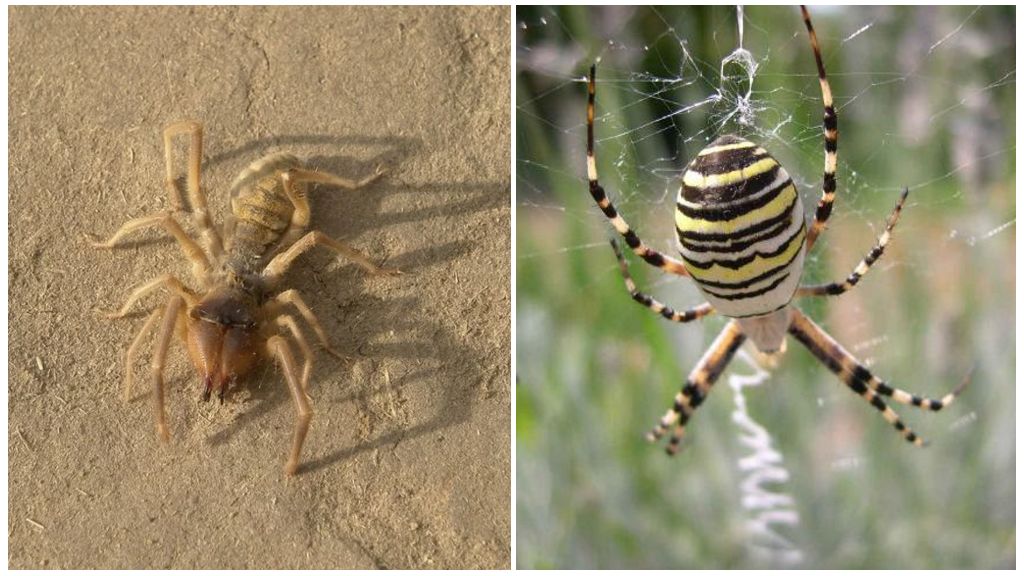
Argiope
A beautiful spider that can only be distinguished from a wasp by its long legs. Due to its color, it is also called tiger, zebra, wasp. Like all spiders, it is not without poison. Bite argiope maybe by accident, but does not pose mortal danger. Swelling occurs on the affected area. In the presence of allergic reactions, it is necessary to take antihistamines.
Ticks
Out of 23 types of ticks in Crimea, 4 species are carriers of encephalitis. They live everywhere among stunted bushes and in the grass.
Important!
The largest number encephalitis ticks It is registered in the mountain and foothill regions of the peninsula, in the forest-park zones of Alushta, Yalta, Simferopol, Bakhchisarai. There are two activity peaks: from May to June and in August-September.
If bitten tick, it is necessary to carefully unscrew it clockwise, using a thread for these purposes, or contact the nearest medical center to remove the offender. At the end of the procedure, the tick must be placed in a container and taken to the laboratory for research. Such a measure will make sure that the aggressor was not a carrier of encephalitis, Lyme disease, borreliosis.
Scolopendra
Another creature that does not belong to insects, but on the impressionable, is capable of catching fear. Crimean Scolopendra from the order of ringed millipedes, it mainly lives in the natural environment, but it often creeps into residential buildings. It is found in almost any part of the Crimea.
Appearance outstanding:
- The color is golden, yellow, olive shades.
- Length reaches 15 cm.
- Round eyes and long antennae are clearly distinguishable on the head.
- Along the body are short, but very fast and almost constantly in motion limbs.
Interesting!
How many legs a millipede has depends on the number of segments, which is affected by the age and type of individual. A scolopendra always has an odd number of pairs of legs and theoretically there can be from 15 or more. The record holders for the number of legs are giant millipedes, which have 171 pairs.
Crimean scolopendra is active at night. If he feels aggression, begins to attack. Scolopendra Bite painful, immediately there is redness, swelling. In people with bronchial asthma, reduced immunity, allergy sufferers can provoke an attack of suffocation, fever, rash.
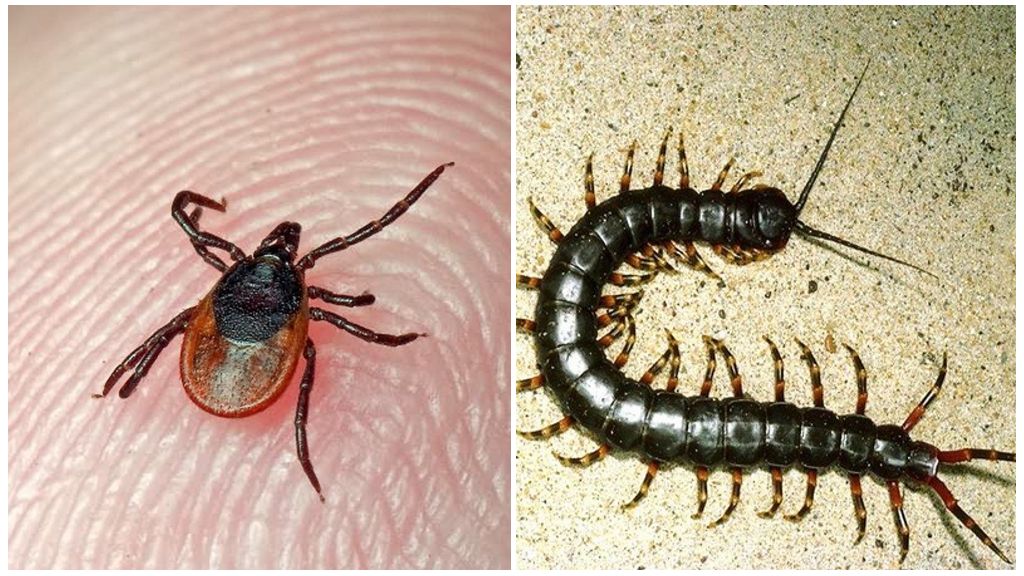
Beautiful and unusual peninsula entomofauna
The most beautiful insects in Crimea live not only in protected areas. Unusual specimens are found in parks, squares and even in personal plots.
- Giant scolia wasp. The view is on the verge of extinction and is therefore listed in the Red Book. The female's size reaches 5.5 cm. Against the background of the black body, the wide purple wings and bright yellow sternum look impressive. The whole body is covered with black and red villi. The insect has not only a beautiful bright color, but also an extraordinary way of life. Scoli larvae parasitize in larvae rhinoceros beetlesas well as Khrushchev. The insect builds numerous passages in the soil, looks for the victim, paralyzes it and lays one egg at a time. So the offspring of chines does not experience a lack of nutrients, gradually eating away the innards of the host, it eats vital organs only at the end. Giant chines are not only a decoration of the Crimean entomofauna, but also are among the largest insects of the Crimea.
- Xylocope is a solitary hunter bee, often referred to as a purple bumblebee because of its color. The size of the insect reaches 3 cm. The body is black metallic, densely covered with black hairs, decorated with small transparent wings with a purple tint. Not distinguished by an aggressive disposition, the presence of a person ignores.
- The largest butterflies in the Crimea are Saturnia pear, it is peacock eye, wingspan 15 cm, machaons with a wingspan of up to 95 mm, a podalirium with a wingspan of 7.2 cm and polyxene (wingspan of 5.4 cm). In addition to the size of the butterfly stand out with an original pattern on the wings. It is very rare to see the polyxena, since the view is on the verge of extinction. The feed base for the caterpillars of this butterfly is only 4 species of vines.
- Several species survived in Crimea butterflies: oak, oleander, etc. Occasionally, a rare species is encountered - the Dead Head. The individual is notable for the fact that there is a drawing on the chest that resembles a human skull. The caterpillar of the Dead Head is also characterized by a memorable appearance - bright yellow, yellow-blue, yellow-lemon with blue oblique stripes. At all stages of development, hawks of this species are capable of making sounds.
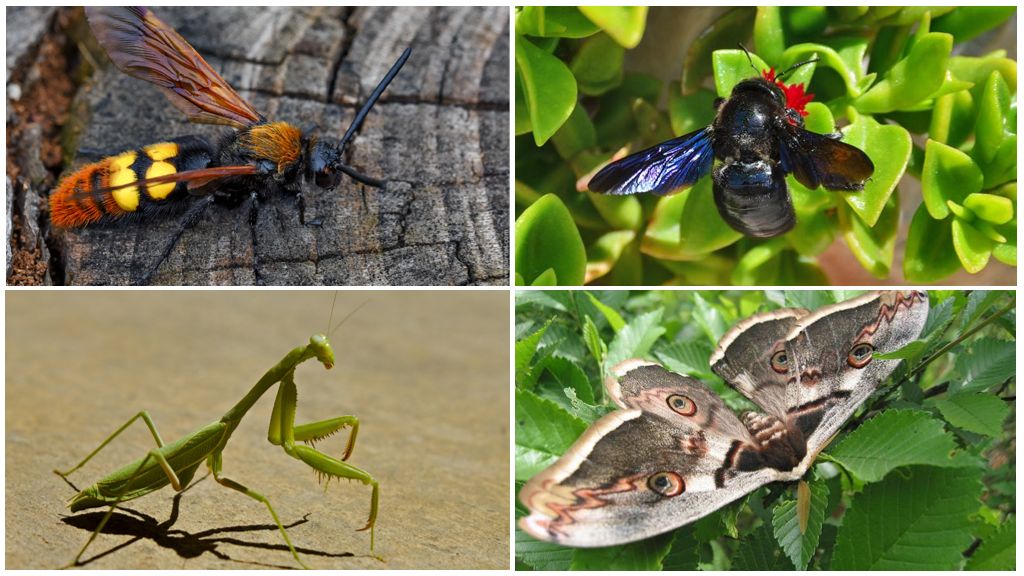
- Mantis. The sizes of individuals reach 7.5 cm in the female. Males are somewhat smaller. The color depends on the surrounding vegetation and varies from brown to green. There is a rare extraordinary species of mantis in the Crimea - striped empusa. It is difficult to see the insect, despite the fact that it reaches 6.5 cm in length. The body of the mantis is so thin, it looks more like a stick or blade of grass.
- Crimean ground beetle - one of the most beautiful bugs of Crimea. The color of green, blue tones. The coarse-grained covering of the body creates an optical illusion that the insect changes its color and shimmers in different shades.
- Grasshopper Acrid. A harmless insect conquers with its size. Females grow up to 8 cm.
- Speaking about the insects of Crimea, one cannot help but recall the night singers - cicadas. Unlike crickets, their singing can be heard only in the daytime. Only male individuals are endowed with singing abilities. Females are silent.
- Rhinoceros beetle. A rather rare specimen, which leads to a reduction in the number of chips. Only males have a horn. Insects grow to 5cm. The shell seems lacquered, long paws stick out from under it, the abdomen is densely covered with hairs. Larvae of the rhinoceros beetle are very similar in appearance to the larvae of the May beetle, which is why they are often destroyed.
- Stag beetle. No less beautiful than a rhino. It is inferior in size to its fellow giants from Europe. Females are also devoid of horns. It is rare in mountain forests. Red Book Insect.
- Dragonflies of Crimea deserve special attention. Entomologists studied 60 species of these insects. All of them are predators and strike with a variety of color. Among large specimens, the large rocker stands out, the trellised dragonfly with blue wings, the watchman-emperor.
The description of all the insects of the Crimea does not fit in the multivolume encyclopedia. Entomologists have been studying them for more than 200 years, but still newer and newer species are opening up.
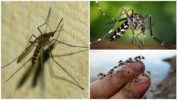
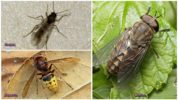
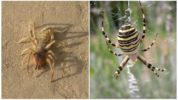
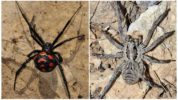
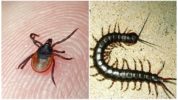
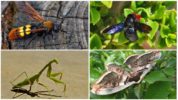




Crimean ground beetle in danger from the end of the abdomen spews caustic brown fluid with a pungent odor, which, if it comes into contact with the eyes, can cause pain and quickly passing conjunctivitis.